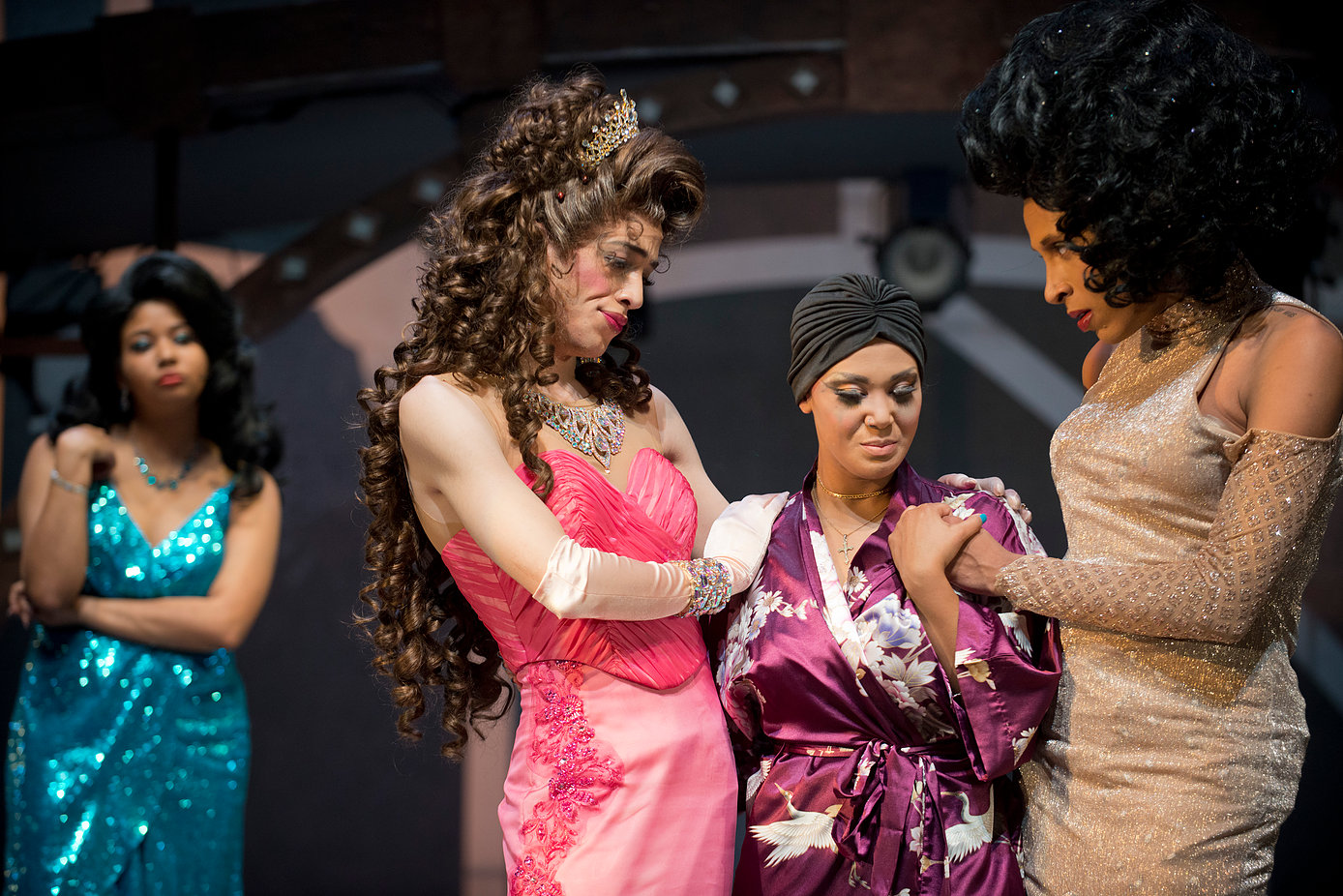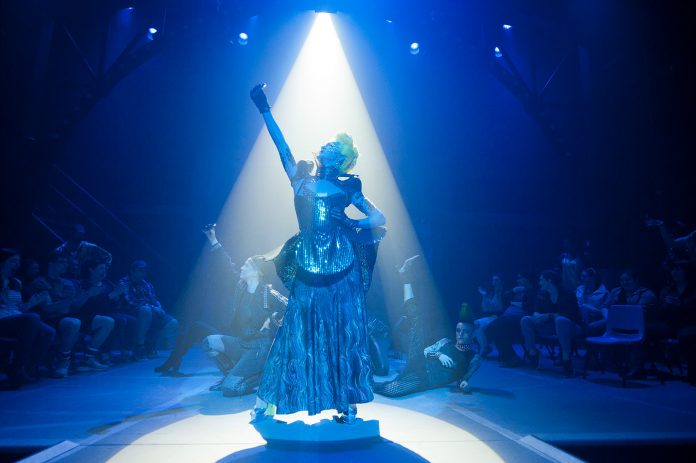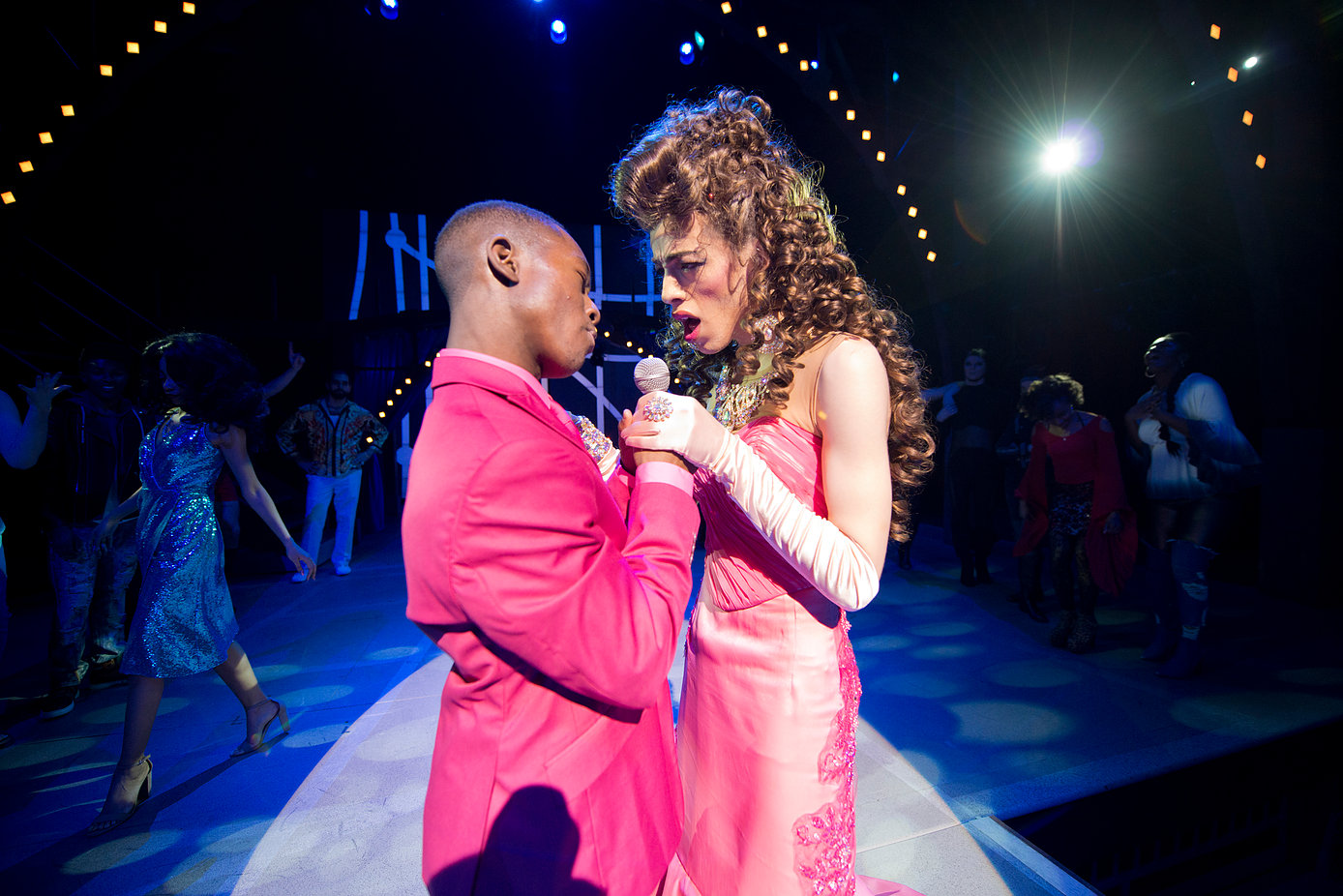It is not very often that a piece of art is born perfectly speaking to its time, addressing the struggles, victories, and needs of its moment with eloquent ease and practiced posture. Refusing to shy away from topics that others might skirt around without a backwards glance, the piece presents its platform freely, openly: it has nothing to hide and all to share. When a piece like this comes around, then, and leads its audience into a relevant, important story – especially one told by those who have lived it – people can’t help but notice. And when Wig Out! opened in the Baker Theatre on Mar. 30, notice they did.
Wig Out! is a show about two competing drag houses getting ready for a ball. But it is actually about way more than just that,” Ogaldez said, “It is about the relationships and evolving lives of the people in each house. It is a magical and alluring look into the world that a marginalized people have crafted for themselves in the absence of biological homes.”
This perspective on the show is shared by director Troy Dwyer, whose personal experiences have fueled his desire to bring these often overlooked or even feared storylines to a mainstage setting.
“I saw the London production of Wig Out! in 2008 and was struck by how dynamic the text was,” said Dwyer, “I was also taken by the fact that the central protagonist, Wilson/Ms. Nina, is both a trans person and a romantic lead. This was something I had only ever seen once before – in the excellent 1999 film Boys Don’t Cry – and as a queer person, it really energized me. The play makes no bones about Wilson/Ms. Nina’s status as a romantic figure; the character is at once a leading lady and leading man. But unlike Boys Don’t Cry, which focuses on the very real dystopian relationship between transphobia and mortal violence, Wig Out! seeks to touch the utopian possibility of surviving despite trans- phobia. The heady, celebratory atmosphere of the Ball- room, even though it features high-stakes competition, is so joyous and defiant as to provide a vital alternative vision for the richness and joy of queer, trans life. The play also has amazing roles for actors of color. As the Theatre & Dance Department has become increasingly intentional about continuing to diversify our mainstage offerings, Wig Out! made all kinds of sense. It’s written by a queer playwright of color to be performed by ac- tors of color.”

Photo credit by Ken Ek.
It is exactly this boldly intentional representation that drew so much support for the show – from continuously large, passionate crowds to instant standing ovations to copious social media posts about the impact of Wig Out! on its viewers, this performance won’t soon be forgotten in the Muhlenberg mind. For two-time viewer Karlie Zabin ’20, the show hit especially close to home.
“As an audience member who identifies herself as part of the queer community and is a performing artist, Wig Out! meant so much to me,” Zabin said, “In every class as a dancer, I am encountered with and taught things regarding race and gender, which are obviously two of the central focuses of the show. Every style of dance in Wig Out! I, as a white dancer, have been taught – but often without context. Black culture and drag culture has shaped the world that we, as young Americans, live in every day – in our exchanges over the internet and through our media – and we are not even aware! We all ‘throw shade’ sometimes, but what about shining a light on the fact that this term came from drag? … As college students, we soon are going to be the ones who shape this country and what it represents. I believe that this show is a fantastic jumping off point to under- stand the acceptance that all people deserve.”
Though the show’s end result was certainly spectacular, perfection was by no means achieved in a day – or even a few months, for that matter, as recounted by Dwyer.
“One of the biggest challenges was coordinating the development of the costume, make-up and wig designs so the final looks were coherent,” said Dwyer, “This process started back in July of 2016 when guest Costume Designer Andy Jean and I first started collaborating. Then in September, our guest Make-Up Designer Joe Dulude II (who was this year’s Baker Artist in Residence) and our guest Wig Designer Bobbie Zlotnik (aka ‘Bobbie Pinz’) came into the mix. There was a lot of back and forth across the fall about how to calibrate the drag looks so they had a coherent aesthetic and also served the production.
“My favorite AND most challenging aspect of the show was the dance for sure,” Ogaldez said. “I never considered myself a dancer before, but Sam- my [Reyes, our choreographer] really helped me build confidence in myself as [he was] incredibly patient and willing to work with me. It was an awesome experience to help create a detailed and intricate story without even saying lines.”
Whether it was through dancing, singing, acting, or drag (which might be a bit of all of the above), Wig Out! has certainly placed itself at the very fore- front of current theatre at this school. I, for one, walked out of Baker with an exhilarated smile on my face, asking everyone around me if there were any seats left for other shows during the weekend. Having recently embarked on a foray into the world of drag culture, I could not wait for this show and had sky-high expectations for it, all of which were met and surpassed. The makeup was superb, the costumes were jaw-droppingly gorgeous, and the actors made me cycle through every emotion possible in two and a half hours – but even these are not the most important or impactful take-aways from this story.
This is real. Beyond the play, this is our world. Beyond the play, we must take action. As said by Troy Dwyer:
“The ‘bathroom bills’ that states like North Carolina are passing, which restrict people from accessing public facilities based on the genders they were assigned at birth, mischaracterize trans people as unnatural, even monstrous. There’s a quote I love by the Dominican writer Junot Diaz in which he says, ‘If you want to make a human being into a monster, deny them, at the cultural level, any reflection of themselves.’ I can’t help but wonder whether the folks behind the bathroom bills might feel differently if, somewhere along the line, they’d received more reflections that people like Wilson/Ms. Nina are real, whole subjects…not objects of monster-like otherness. But beyond this, Diaz wants folks who are different from the norm, whatever that may be, to see them- selves represented in stories – fiction, film, TV, plays – so they don’t feel like monsters. As a queer educator, this resonates deeply with me. I’m surrounded by a lot of amazing young queer people, some of them trans, and many of them of-color. And like all of us, they want to see themselves reflected back at them, from the heart of a beautiful, hopeful story.”
Brooke is a senior double majoring in English and Media & Communication. She's passionate about french toast, Kate Bishop, Steven Universe and the ocean coasts of Ireland. On campus, she is a Writing Tutor, Orientation Leader and member of the Girls Next Door, Muhlenberg's all-lady a capella group. She could not be more excited to serve as your Editor-In-Chief this year!























